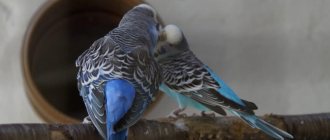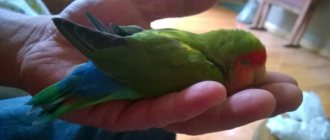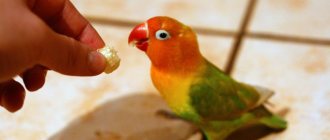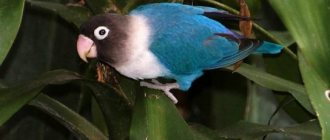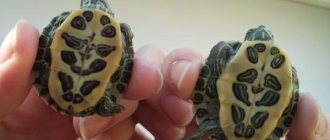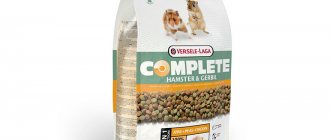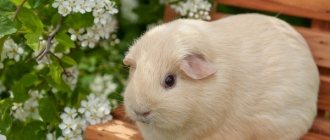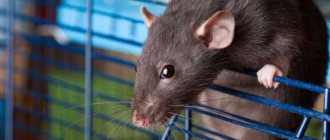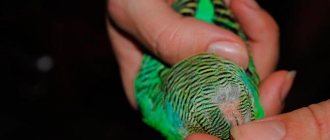- home
- Parrot
- Breeding
04/15/2019 Breeding cockatiels is a fascinating process, where each clutch is different from the previous one. But in order to get healthy offspring, you should take into account some nuances and be prepared for some difficulties.
general description
A medium-sized parrot from the Cockatoo family weighs 100 g. The body size is about 30 cm, the tail length reaches 15 cm, the wingspan is 40 cm. The beak is small, but quite powerful. A distinctive feature of cockatiels is a high crest on the head.
Natural coloring is not very bright; males look somewhat more colorful than females. Chicks at a young age have the same faded coloring as females. Only when they reach the age of puberty do males acquire their characteristic plumage. Usually changes begin to occur from 6 months of age.
Corellas reproduce well in captivity; artificially bred parrots have a wide variety of plumage color options. The most common mutation is lutino. Individuals of this species are yellow in color. They have red eyes and orange cheeks.
Cockatiels live only in Australia. These birds are monogamous. Their breeding season coincides with the rainy season and lasts from October to December. Parrots make their nest in the hollow of a dead tree at a height of 2 m above the ground. The female lays 4 to 7 eggs, one egg per day.
Both parents are equally involved in incubating eggs and feeding chicks. The chicks hatch after 17-23 days and are completely helpless. After 5 weeks, the chicks leave the nest. They reach puberty at 6-11 months.
In the wild, cockatiels live 12-15 years. If kept at home, a parrot can reach the age of 25 years with proper care.
Egg laying and brooding period
By organizing the necessary climate and hanging a nesting house, you will stimulate the reproduction of cockatiels. The mating period of parrots lasts seven to ten days, in rare cases - about a month. After about ten to fourteen days, or a little later, the first testicle appears. Before laying an egg, the female begins to noticeably worry, her breathing quickens.
The female lays an egg per day or every other day. As a result, the clutch should contain from three to seven eggs. When the female lays her second or third egg, she and the male take turns incubating them. The laying period sometimes reaches ten hours, during which time the male warms the clutch.
From time to time, the female turns over and rearranges the eggs so that the chicks do not stick to the wall of the shell and warm up evenly. The female rarely leaves the nest to go to the toilet and have a snack. The rest of the time she is fed by the male.
In about twenty-one days the first chick should appear. You will know this by the characteristic squeak. In whatever order the female laid her eggs, the babies will appear in that order.
Start cleaning the nesting house only two weeks after the last chick hatches. If parents show aggression, it is better to postpone cleaning. Excessive worry will only harm cockatiels and their babies.
Features of behavior
When planning to breed cockatiels at home, pay attention to the behavioral characteristics of these parrots. The emotions they experience are clearly demonstrated by the parts of the bird’s body:
- Excitement, alertness - the crest stands upright, eyes wide open.
- Aggression, preparation for an attack - the crest is slightly tilted and pressed to the head, the pupils are dilated, the feathers are ruffled, the tail is loose. The bird clicks its beak and flaps its wings.
- Playfulness - the crest is held straight, lightly touching the back, eyes narrowed.
Parrots have a harsh and unpleasant voice. The more excited the bird is, the higher the voice.
If a cockatiel hisses, it is a sign that it is preparing to attack. A parrot reacts this way if it believes that an attempt is being made to take over its home. You should not stick your fingers between the bars; cockatiel bites are very painful.
Corella is sensitive to affection. She enjoys scratching her head and ruffling the feathers on the back of her head.
Cockatiels are shy. When experiencing stress, untamed parrots can become aggressive when given a new owner. It is better to buy birds from a nursery or from trusted breeders. It is not recommended to adopt an adult, unsocialized bird: it will not be able to get used to its owner and will cause him a lot of trouble.
Cockatiel nesting house
Any room for parrots of this species can be selected, the main thing is that the temperature regime is maintained and the appropriate humidity is maintained. Cages and houses must be equipped in such a way that cleaning and disinfection are easy. The presence of ventilation is desirable, but you can simply ventilate the room every day by opening the window. In this case, it is better to cover the cage with a special cover or take it to another room. The slightest hypothermia of the eggs will lead to the death of the embryos.
You will also have to think about a place for flying. Future parents should not sit locked up all the time; this will negatively affect their emotional state. Cages will imitate nests; these are wooden boxes. Only 3 walls are made of wood, the main one is made of mesh, and a door is thought out for the birds to escape. Sawdust, straw or sand are placed at the bottom (layer width 4 cm). To prevent microbes or parasites from appearing in the bedding, add chamomile to it. In nature, these parrots live in dry hollows; in pet stores you can find artificially created wooden houses. It is important to think about the roof of the tub; it should open easily, so you can watch the future chicks without unnecessary noise. Inexperienced bird lovers build nesting houses that are too large, but in a large space the chick can get separated from its mother and freeze.
Houses with cockatiels are cleaned regularly; dirt and droppings can lead to the development of diseases. If the female is weak, she will not be able to breed offspring and all efforts will be in vain. First, the female settles in the future nesting house; she must spend about a day in the new place. This way the bird will get comfortable and have time to look at everything, only then will the future father of her chicks move in with her. You need to carefully watch the cockatiels; if they like each other, the male will begin to court the female. He will sing, perform a mating dance and preen his feathers. Sometimes you have to be patient; mating can last from 7 days to 6 weeks.
Breeding
Breeding cockatiels is not difficult; As soon as parrots are 6 months old, they are already able to reproduce. But it is better not to subject a fragile organism to such a test and give the chicks the opportunity to grow up to one and a half years old.
In nature, parrots breed in the fall. At home, you can encourage cockatiels to mate by artificially creating suitable conditions for them; for this you need to:
- Find compatible partners.
- Ensure correct lighting conditions.
- Offer complete food.
- Place a nest in the cage.
It is advisable to purchase a spacious tall cage of rectangular or square shape. To breed a cockatiel at home, you need to provide a pair of parrots with a large cage, at least 70x70x150 cm.
Walk
Like other types of parrots, regular walks are absolutely necessary for the cockatiel. When letting a bird fly around the room, you need to follow safety precautions. All other pets must be removed from the premises immediately. Windows and doors should be closed to prevent birds from flying out or a cat or dog from entering the room.
It is advisable to cover the mirrors with some kind of fabric so that the bird does not accidentally dive on them. Plants can also be removed from the room so that the parrot does not peck at them. The duration of the walk should be approximately 1-3 hours. While the parrot is walking, you can clean the cage.
When the parrot flies around the room, you need to carefully monitor it.
Compatibility issues
When a pair of opposite-sex cockatiels live together from a young age, and they have no alternative to meeting other partners, their friendships can gradually turn into marital ones. The resulting mutual interest will clearly manifest itself. The birds will sit side by side on a perch and gently touch each other’s feathers with their beaks. The male's readiness to mate is demonstrated by the increased intensity of his chants.
If your pet is raised alone and aggression occurs when a foreign parrot is introduced between the cockatiels, this may be due to increased testosterone levels in the male. A short separation usually solves this problem. If mutual hostility does not go away, you will have to take care of acquiring other marriage partners.
How to choose a mate for your cockatiel
To breed good offspring, you need to choose two healthy parrots. They must be healthy and mature, and not related to each other.
What to feed
When breeding cockatiels at home, parrots are fed well-balanced food. A grain mixture for medium-sized parrots is suitable for this. Additionally, add to the diet:
- grated carrots;
- pieces of cabbage;
- slices of apple, pear;
- plantain seeds;
- dandelion leaves;
- a few drops of vegetable oil;
- sprouted grains;
- honey (2 g 1 time per week);
- boiled egg (2 - 3 times a week, a little).
Honey and butter can be given on a small piece of bread. Birds love to chew on fresh tree branches. The cage must contain special mineral supplements in the form of sand and pebbles.
After the birds settle into the nest for brooding, soft egg food should be excluded from their diet. Its presence stimulates the female to lay more eggs.
When the chicks hatch, the mashed egg becomes their main food and is returned to the feeder. Grown chicks, feeding on their own, switch to the regular diet of parrots.
Parents feed their babies by regurgitating food directly into their beaks. Chicks can be taken from their parents for artificial feeding when their eyes open. This usually happens on days 10–12. The “foster babies” are fed liquid warm porridge made from infant formula. You can also feed “natural animals” in order to accustom them to human hands.
Communication and training
How to quickly tame a cockatiel? The main rule here is regularity and gradualness. You can’t try to put a parrot on your hand right away. He will simply get scared and show aggression. You must gradually, every day, bring your hand closer to the bird. He must get used to it and not feel danger from the owner. In order for a parrot to jump onto your hand, it must contain his favorite food. Once the parrot is completely tamed, you can begin to teach it to speak.
Regularity and gradualness are also important in teaching speech. You need to start with the simplest words, which contain the vowels o and a. After the pet has mastered them, you need to move on to more complex words, and then to phrases. During lessons there should be a friendly atmosphere. The use of punishment and violence against a pet is unacceptable. The optimal duration of classes is 15-25 minutes, but they should take place every day. If these conditions are met, the cockatiel will learn to speak quite well.
Requirements for daylight hours
Long daylight hours stimulate parrots to reproduce; for cockatiels it should be at least 16 hours. Before this, the birds are kept on a shortened day for a month, its duration is 8 - 10 hours. During this period, parrots must undergo molting, their gonads are activated.
The required length of daylight can be ensured with the help of additional sources of artificial lighting and dense material thrown over the cage. The parrot needs to add more “day” gradually, 10 minutes every day. Too sudden a change in conditions can negatively affect his sexual function.
Comfortable indoor conditions for the breeding pair are maintained with a constant air temperature of 18–20 °C and a humidity of 50–60%.
Feeding the chicks
For three to four days, the female feeds the chicks with a yellowish-white liquid - crop milk. After this, the cockatiel begins to give them semi-digested food received from the male.
If the birds, due to fatigue and lack of parental instinct, did not feed the chicks, you will have to help them.
Feed the chicks baby formula every two hours. It should be liquid and heated to a temperature of thirty-five degrees. For convenience, use a syringe without a needle.
After a week, start feeding the chicks every three hours. When they are two weeks old, add well-cooked liquid porridge made from crushed millet to the baby food. Increase the amount of food so as not to feed babies at night. When the chicks are a month old, start feeding them grain mixture from a spoon five to six times a day until they begin to eat on their own.
If you have already bred cockatiels, please share your experience with us. Perhaps you have something to add.
If you liked the article, please like it.
Arrangement of the nest
A nest placed in a cage serves as a signal to encourage parrots to mate. This process usually takes about a week, but there may be exceptions. A special box is used as a nesting box; it can be bought in a store.
By the behavior of the parents, you can accurately determine when eggs will appear in the nest. The birds alternately perform the duties of a hen: during the day the male takes care of the eggs, at night the female replaces him at post. After 21 days from the moment of laying, the chicks will begin to appear.
Why doesn't the parrot hatch eggs?
The presence of the nesting house in the cage should stimulate the female budgerigar to begin laying eggs. In the worst case scenario, the female's ovaries do not work, so she cannot have chicks. ... The female budgerigar laid an egg, but does not hatch it.
Interesting materials:
Where is the C ProgramData folder? Where is the AutoCAD templates folder? Where is the brake pedal on an automatic? Where is the pink sand beach? Where is the Borodino battlefield located? Where is the Expression Builder in Access 2007? Where is the Toyota Auris cigarette lighter fuse located? Where are the tributaries of the Volga? Where is the Business Bonuses section in The Sims 4? Where is the speech center in the brain?
Female and male
The photo shows a female and a male cockatiel.
Sexual dimorphism in cockatiels is weakly expressed. The male Corella is colored in richer shades and has distinctive white stripes on its wings. The plainness of the female’s coloring can only be noticed in comparison with an individual of the opposite sex. She also has transverse pale yellow stripes on her tail, and oval spots of the same color can be found on the inner surface of her wings. Young individuals retain the same color as their mother until the completion of the juvenile molt. However, after molting at 9-12 months, it changes in males.
In cockatiel chicks, sex can only be determined by behavioral reactions. Adolescent males sing loudly, bang their beaks on hard surfaces, straighten their shoulders and stomp, trying to attract the attention of females. Those, in turn, behave modestly, take a low posture and throw back their heads, showing their readiness to submit to the male.
Matching
Cockatiels are monogamous and by nature choose a mate for life. To breed in captivity, they also need stable, strong relationships with others and mutual sympathy. The breeder must give the birds a choice: an aviary containing several males of different sexes is suitable for this. This way, it's more likely that you'll get a compatible pair in no time.
Good breeding offspring of roosters is obtained by following several rules:
Physical health
When choosing breeders, you should carefully monitor their emotional and physical state. The reproductive capacity of the cockatiel is maintained despite the disease. But it is impossible to predict which chicks will appear in a weakened bird. Injured, melting or sick parrots should not be allowed to mate.
Carefully. An obese bird should first be brought back to normal before being prepared for breeding. An overweight parrot gets tired quickly and cannot sit on eggs in one position for a long time.
Not related
Breeding closely related cockatiels is only justified if the goal is to preserve the characteristics of the mutation (for example, lutino). Inbreeding, the breeding of related correlates, has negative consequences. Related individuals produce offspring with external defects and deviations in basic functions:
Chicks grow slowly as they age. Such chicks rarely give birth to viable parrots.
Suitable age
Physically and functionally, males are ready for breeding at the age of 9-10 months. Until then, their reproductive system matures, but in reality, correlates under one year of age remain infants. They do not want to take care of their chicks, because they themselves are actively growing and spending their vital resources.
Breeding young correls at home is not always successful: the female abandons the brood, and the raised chicks often die. Carefree parents do not have protective skills, and the maternal instinct is not yet sufficiently developed. There is a high probability that the eggs themselves are unfertilized. Problems arise with immature females: inexperienced ones cannot push out a stuck egg.
At the age of one and a half to two years, breeding is most successful. By that time, the pair of cockatiels will be sufficiently prepared, their bodies will be stronger. Childish playfulness will be replaced by calm maturity, the birds will feel the need to continue the family tree.
On the fields! The best producers are considered to be cockatiels from 2.5 to 5 years old. Later, sexual function gradually decreases and adult parrots become completely infertile.
Laying and incubation of eggs in cockatiels
As a rule, a hanging nest serves as an incentive for a pair of cockatiels to breed. So, to start the nesting process, it is enough to equip a breeding room, hang a nest box from the cage, form a pair of parrots and provide them with adequate food.
After a nest box appears in the nesting room, the male will begin to display. This process is difficult to confuse with anything: the parrot flies or runs around its girlfriend, making various sounds. In addition, the displaying male puffs out his cheeks and knocks with his beak on perches and other objects in the cage. During this period, the feathers on the male's head rise.
Young females behave like males: they dance around the gentleman, peck at perches, and behave aggressively towards other females. But in old females it is quite difficult to determine readiness for reproduction, since they behave much calmer, sometimes not paying attention to the male.
The male cockatiel becomes very affectionate, cares for the female all the time, sorts out her feathers, making characteristic sounds, and constantly feeds her from his beak. He constantly walks around the female with his wings spread.
The female reciprocates: bows her head, sits with half-closed eyes; birds often “kiss.”
Showing male
The mating period for cockatiels lasts 7-10 days. Usually after 8-10 days (sometimes after 2-3 weeks) the first egg appears in the nest. The female lays subsequent eggs at intervals of 1–2 days. In most cases, a cockatiel clutch contains 5–7 eggs.
Unlike other species of parrots, cockatiels take turns incubating their eggs.
Closer to the appearance of the chicks, the female usually incubates the eggs, while the male performs the duties of the breadwinner (if there are several pairs of parrots in the nesting room, the male guards the nesting site, driving other birds away from it).
Periodically, the female turns the eggs over, simultaneously moving them from place to place, which prevents the fusion of the shell of the egg and the embryo, and also ensures uniform heating of the clutch (the temperature of the eggs lying on the edge and inside the clutch is very different). The female leaves the nest box only a few times during the day, only to empty her intestines.
Interestingly, the weight of the litter of a female incubating an egg is approximately equal to 10% of her body weight. Only after the end of the nesting season does the frequency of bowel movements and the weight of excreted feces return to normal.
The incubation time of eggs is on average 21–23 days. It is necessary to take into account that various external factors can shorten or increase the development time of embryos. Females begin to incubate eggs immediately after laying 2-3 eggs. Humidity during incubation should be about 60-70%. You can maintain it with the help of air humidifiers, spraying the walls of the nest with water 3-4 times a day; in winter, you should hang wet towels on the radiators. You can also offer the birds a bath. Humidity is important for embryo development.
If you notice a small crack on the egg, you need to seal it. This can be done using BF-6 glue, which must be applied in a thin layer to the damaged area. You can try to seal more serious damage with wax.
It happens that young females stain their eggs with droppings. In this case, the eggs must be carefully removed from the nest box and washed thoroughly. To do this, place them in warm water (35–40 °C) and leave in it until the dirt dissolves.
Sometimes the embryos die during the development of the egg. When it comes to isolated cases, there is no need to worry. But if embryos die quite often, most likely there are genetic reasons for this. In this case, it is recommended to contact a veterinarian.
cockatiel eggs
Many hobbyists when breeding cockatiels are faced with another problem: during the first, and often during subsequent clutches, the female lays only unfertilized eggs. This phenomenon can be caused by the following unfavorable factors: › long plumage covered the cloaca area and prevented mating (it is advisable to trim the parrots in the cloaca area); › the perches in the cage were not securely fastened (the perches must be designed in such a way that the female could firmly hold on to them); › the manufacturer’s food was insufficiently nutritious and fortified (include protein food, vitamins and minerals in the diet); › the pair did not rest after the previous nesting season (it is undesirable to mate birds more than 2 times in a row; after 2 nesting seasons, the birds must be given a rest for at least six months); › the temperature in the breeding room was below 15 °C (increase the temperature in the breeding room); › the breeders were unwell (call a veterinarian or examine the pets yourself).
Fertility check and fertilized eggs
By candling the eggs (for example, by looking at them in very bright light), you can tell whether the eggs are developing or not. You can check the eggs on the fifth day from the start of incubation. The longer the egg develops, the darker its contents become as the chick grows and develops. The best way to check is to use an ovoscope. Thanks to it you can even see the heartbeat of a small bird. You can purchase an ovoscope for testing, or you can assemble it yourself. You can read about this on the Internet. The main thing is to handle the eggs as carefully as possible. They can be damaged by sharp bends, turns, or shaking. Remember to wash your hands before handling them and don't hold them for too long. The surface of the egg is porous and harmful bacteria from your hands can enter the egg and harm the growing chick.
If, when checking the egg, you see a network of blood vessels with a dark spot in the center, then it is fertilized. You may also see an empty area in the wider part of the egg. This is an air chamber and will become larger as the chick grows. If the egg is not fertilized, you will not see blood vessels. It will appear evenly light with a brighter ball of yolk in the center. Unfertilized eggs do not need to be removed from the nest unless they are damaged. After the chicks hatch, they will provide an additional source of warmth for them. If the egg was fertilized, but the chick died at some stage of development, then you may see that the surface of the egg appears to be covered in spots. You will not see tiny blood vessels like in a living egg, since these vessels have become denser after the death of the chick.
Infertility in cockatiels
Female cockatiels are capable of breeding up to 8-10 years, males up to 12-14 years. There are always exceptions: healthy, well-nourished birds with a good genetic predisposition to breeding can have offspring longer. But these are exceptions and should not be forgotten.
However, even within these age limits, birds can have problems. Captive-bred birds do not always make good parents. Breeding pairs that lack experience may injure, eat, or abandon eggs and chicks in their first clutches. Sometimes adult pairs cannot begin laying eggs for several months or years. Other couples are unable to reproduce due to infertility. Infertility in poultry can be the result of nutritional problems, as well as medical, environmental and behavioral problems.
Some of the causes of infertility:
- obesity in parents;
- poor nutrition;
- lack of nutrients;
- bacterial or infectious diseases;
- reproductive dysfunction;
- hormonal imbalance;
- inappropriate age of birds;
- unsuccessful mating in inexperienced couples;
- disturbance of birds due to people or animals near the nesting area;
- lack of time allocated for the couple;
- same-sex birds could be mistaken for a couple;
- there is no soft food that birds could feed their chicks;
- daylight hours are too short;
- incorrect nest box;
- too much or little humidity.
